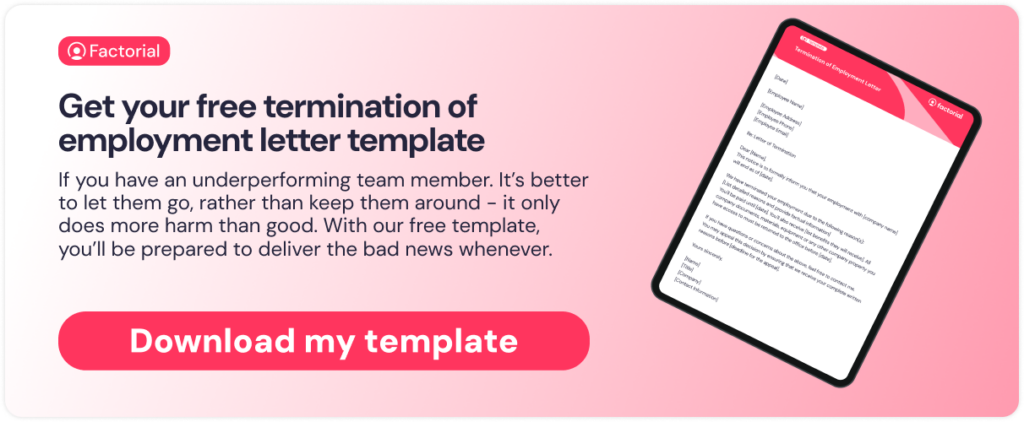Being a manager isn’t always as glamorous as it may seem. The reality is – most managers have to make difficult decisions and have hard conversations weekly. Such as telling an employee they are being let go. Terminating the occasional employee contract is an unavoidable fact of life. Given that this is a hard moment for both employee and manager, having a termination letter ready to go is a good idea. A termination of employment letter serves as a formal notification that provides details of the termination. This includes the cause of termination, effective date, severance pay, and any other related information.
Having a clear termination letter template is ideal for when these situations arise. It ensures managers, HR leaders, and employers are equipped to handle dismissals. In this guide, we will cover employee termination letters, the importance of termination letters, and how to write one. Lastly, we will provide samples of termination of employment letters to help you get started on yours.
What is employee termination?
Before we look at how to write a termination letter to an employee, let’s start with the basics: what is employee termination?
Employee termination is when an employee’s employment with you comes to an end, either voluntarily or involuntarily:
- Voluntary termination: when an employee resigns from your organization because they have found a new job, or they have reached retirement age.
- Involuntary termination: when you terminate an employee’s contract due to justifiable reasons (they are dismissed, fired or laid off from the company). This includes termination without cause (typically due to economic circumstances), termination with cause (typically due to performance issues or misconduct), and termination due to the end of a business contract.
In the case of voluntary termination, an employee will usually provide you with a resignation letter confirming their notice to leave their position. However, in the case of involuntary termination, it is your responsibility as the employer to issue a termination letter.
Related: Watch this short, honest conversation between leaders about how to approach underperformance thoughtfully.
What is an Employee Termination Letter?
So, what is an employee termination letter exactly?
A termination letter, also known as a pink slip, letter of separation or notice of termination, is a form of written communication that notifies an employee that you are terminating their contract of employment. This might be due to poor performance, incompetence, unacceptable behavior, layoffs, or any other justifiable reason.
Issuing a letter of termination is an important final stage of the employee lifecycle. It provides employees with all the information they need to begin the offboarding process on the right foot. It also helps you fire employees in the right way (or lay off employees correctly in the case of termination with cause) so that you avoid any potential disagreements or legal disputes.
Whatever your reasons for terminating an employee’s contract, your letter of termination should include the following information:
- Termination date
- Type of termination (with or without cause)
- Reason(s) for termination with supporting evidence
- Next steps for compensation, health insurance and benefits
- A list of company items that the employee needs to return
- Notification of agreements that the employee signed, such as non-disclosure agreements
- Information on next steps in relation to internal HR processes, such as offboarding and exit interviews
- HR contact information for further questions
It’s essential HR teams and managers understand the termination process to ensure a smooth transition for both the employee and the company. Additionally, this guarantees the company is compliant and adhering to employment laws in order to avoid any unfair dismissal charges. A well-written termination letter can provide clarity and closure to your ex-employee. Ideally, your company would have termination of employment letter templates ready to use for a variety of situations. That way you can tailor it as needed.
Types of Involuntary Termination
As we already mentioned, involuntary termination typically falls into three categories: without cause (also known as a ‘layoff’), with cause (also known as ‘being fired’), and due to the end of a business contract.
The termination letter you send will depend on the type of termination that you are processing.
Let’s take a look at this in a bit more detail.
Termination without cause
Commonly referred to as a layoff. This form of termination is typically due to economic circumstances that are outside of the employee’s control. For example, the Covid-19 pandemic and resulting lockdowns of businesses led to an economic downturn that forced many employers to restructure and terminate the employment of a large proportion of their workforce without cause. This was especially notable in the hospitality industry, factories, and plants. Remember, as an employer you are required to file a WARN notice for mass layoffs.
Termination with cause
Termination with cause is when you fire an employee due to poor performance or general misconduct.
In the case of underperformance, it’s important that you follow established internal procedures before issuing a termination letter, such as holding meetings to discuss performance levels and offering coaching to help an employee improve their performance.
In terms of misconduct, this might relate to behavior that violates the company’s values or code of conduct, such as harassment, violence or falsifying records. It also includes any behavior that breaks the law, such as theft or fraud.
End of business contract
The third type of involuntary termination is when an employee’s contract comes to its natural end. This kind of termination typically refers to temporary workers, consultants, or partners, who are supporting the organization within a 1099 contract for freelance work. In this case, the termination is expected so the letter is just a formality.
Is providing a termination letter a legal requirement?
Generally speaking, according to the Federal Labor Standards Act (FLSA), you are not legally required to provide a termination letter. The only exception under this law is if the employee in question is part of a union, or if their termination is part of a larger mass layoff or corporate closure. All other forms of employment usually relate to “at-will” employees, so both you and your employee are legally entitled to end the employment contract at any time and without written consent, provided the reason is justifiable (non-discriminatory and not in violation of contracts or union agreements).
That said, most employers consider it a good idea to provide a termination letter to any employee they are firing or laying off. That way, you document everything, including the date of dismissal, and reduce the risk of potential legal disputes. For this reason, most companies include a termination process in their HR policies. It’s also important that you familiarize yourself with any local laws as termination legal requirements can vary by state.
Understanding the Importance of Termination Letters
As we already know, termination letters of employment act as formal documentation for why you let an employee go. It’s also used to avoid confusion, miscommunication, and potential lawsuits. These letters are vital to help maintain professionalism throughout the termination process. They give a clear overview of the termination conditions and provide a structure on how to fire an employee.
To summarize, the importance of employee termination letters are:
- Transparency: These letters ensure both the employee and employer have a mutual understanding of this termination.
- Employment regulations: Although in the U.S. there is no federal law requiring employers to provide a written notice of termination of employment. However, in certain states, it is mandatory. Take a look at states such as Florida, California, and Texas to see what is required of you. For additional guidance, check out this U.S. official guideline for employers.
- Legal protection: A termination letter of employment is a record of dismissal and can be used to protect the business in case of future wrongful termination claims.
- Offboarding: The offboarding process begins with the termination letter as it outlines the next steps. This ensures all tech access is revoked, any physical materials are returned, and all loose ends are tied up.
How to write a termination letter
Now let’s take a look at a few termination letter best practices to help you understand what you should be including in your letters.
Set the right tone
Whether you’re dismissing an employee due to downsizing, performance issues or misconduct, it’s important to be professional and courteous during all official communications. Keep in mind that whatever your reasons are for letting someone go, your decision will have an impact on their income and health coverage, so try to show compassion where appropriate. Your decision to terminate their employment is also likely to place them in an uncertain position. So, make sure you clearly outline the next steps, so the employee in question understands where they stand and what they need to do before you terminate their employment.
Collect all the information you need
Before you start writing your termination letter, make sure you collect all the information you need.
This will usually include:
- Basic personal information, including the employee’s name, ID number, department, manager’s name, and position with the company.
- The official reason for termination. Make sure you include any supporting evidence (for example, if dismissal is due to misconduct, include information about any preceding disciplinary procedures and meetings).
- The official date of termination.
- Information about outstanding compensation (final paycheck, owed PTO, sick days, etc.).
- Information about benefits (impact on health insurance, unemployment benefits, etc.).
- Any company property that the employee will need to return (company cell phone, ID card, company vehicle, laptops and other devices, etc.).
- Any information relating to severance pay (in the case of redundancies).
- Information relating to signed non-disclosure and non-compete agreements.
Make sure all this information is clearly detailed in your letter.
State a clear reason for termination
It’s important to clearly state your reason for terminating an employee’s work contract. This is perhaps the most critical element of your termination letter as it lets the employee know why they are being fired or laid off.
Make sure you are clear, honest and straightforward with your reasons. For example, if you are firing an employee with cause, make sure you refer to previous written warnings or any documented evidence reflecting poor performance.
For example, you might say:
“This decision was made due to your failure to meet company guidelines. Specifically, you failed to comply with [rule/regulation/procedure].”
You should also invite the employee to contact you if they have any concerns or if they want to appeal your decision. Be prepared to discuss these issues further, but make sure you communicate that your decision is final.
Be clear about the employee’s effective date of termination
Make sure you include the employee’s effective date of termination in your employee termination letter. If you are laying off an employee without cause you may decide to give prior notice to give them time to prepare. However, if you are firing someone with cause then you may decide that their termination will be effective immediately.
Detail outstanding benefits and severance process
Whether you’re firing someone with or without cause, they will likely be due certain benefits. Make sure you provide details about all outstanding benefits and severance payments in your termination letter.
These benefits might include their final paycheck with outstanding wages, and owed PTO and sick pay. If your company offers COBRA or similar health plans that extend coverage beyond the employment contract, you can detail those benefits here, as well.
If you are making an employee redundant, you might also issue a severance package alongside their pink slip. Makes sure you discuss the terms of this severance package with the employee before you issue their official termination letter.
Provide guidance for moving forward
Depending on the nature of the termination, you may need to provide guidance on what should happen next. For example, if an employee will be working a notice period, then you should include a schedule to help them hand over responsibilities to other team members. If you are dismissing an employee with immediate effect, you may need to arrange for security to escort them from the building within an established timeframe (15 minutes, for example).
Make sure you define clear HR procedures for this. That way, you will know which exit strategy to follow for each type of dismissal.
Confirm final details and contact information
Finally, make sure you remind the terminated employee that they must return all company equipment before their last day. This might include ID cards, cell phones, vehicles and any electronic devices.
It’s also important to make sure you provide your contact information. That way, the employee can get in touch if they have any concerns about their dismissal. Also, make sure you request contact information for the terminated employee. That way, you cover yourself in case you need to send them a final severance check, tax documentation, or similar correspondence by mail.
Termination of Employment Letter Templates
Let’s finish by looking at a couple of sample templates. These templates are for the two most common types of dismissal: termination with cause and without.
Termination letter template: with cause
This is a sample termination letter if you need to terminate an employee with cause. Download a PDF version here. This might be as a result of misconduct or poor performance:
[Date]
[Employee Name]
[Employee Address]
[Employee Phone]
[Employee Email]
Re: Letter of Termination
Dear [Name],
This notice is to formally inform you that your employment with [company name] will end as of [date].
We have terminated your employment due to the following reason(s):
[List detailed reasons and provide factual information]
You’ll be paid until [date]. You’ll also receive [list benefits they will receive]. All company documents, materials, equipment or any other company property you have access to must be returned to the office before [date].
If you have questions or concerns about the above, feel free to contact me.
You may appeal this decision by ensuring that we receive your complete written reasons before [deadline for the appeal].
Yours sincerely,
[Name]
[Title]
[Company]
[Contact Information]
Termination letter template: without cause
This is a sample termination letter if you need to terminate an employee without cause. This might be as a result of downsizing or department-wide layoffs:
[Date]
[Employee Name]
[Employee Address]
[Employee Phone]
[Employee Email]
Re: Letter of Termination
Dear [name],
This notice is to formally inform you that your employment with [company name] will end as of [date].
Over the last few months, [company name] has experienced a lack of work in our industry, leading to financial difficulties. We’ve explored various options to increase the need for labor, but unfortunately, our efforts have been unsuccessful. As a result, we’ve decided to reduce the workforce by 20%. It is with deep regret that I inform you that your position will be eliminated effective [date]. This decision is final.
You will receive a final paycheck on [date], in addition to payment for any paid leave days you have remaining. As discussed in our meeting, you will also receive a severance payment of [amount]. Please sign and return the attached claim document to ensure you collect this.
Your healthcare benefits will remain in effect for 120 days post-termination. Thereafter you will have the option of continuing coverage under COBRA.
Please return your company cell phone, keys and ID badge on your last day of employment.
Feel free to contact me with questions or concerns you may have regarding this termination letter.
Please accept our appreciation for your contributions during your employment with [company name].
Yours sincerely,
[Name]
[Title]
[Company]
[Contact Information]
Experience seamless Offboarding with an Offboarding Software. Try it now!




